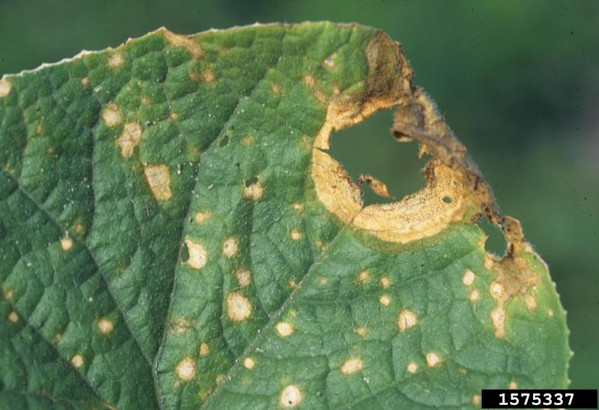Corn is an important and economic host for this disease. In field corn, there are two phases of Anthracnose:
Anthracnose Leaf Blight impacts corn at an increasing rate as tillage systems move more toward no-till and reduced tillage. The fungi overwinter on and in trash from the previous crop. During the early development stages of the crop, the lesions from Anthracnose are small, oval-shaped, and water-soaked in appearance. They are semi-transparent and will enlarge to nearly an inch long, becoming tan in the center and characteristic borders that range from orange to yellowish, and/or red to brown. During wet weather, the fruiting bodies may develop in the center of the lesions and appear as black spots. Later in the season, as the plant develops, these lesions will coalesce and continue to consume leaf tissue. If severe, the leaves will eventually die. The inhibition of photosynthetic processes within the plant can lead to yield loss, and lower test weight. With ideal weather conditions for their survival, the symptoms may appear on the upper leaves as well.
Anthracnose Stalk Rot is a phase of Colletotrichum graminicola that can be of concern at an even greater level. Symptoms of anthracnose stalk rot are usually observed later in the season after tasseling. Water splashing transports the fungi to the stalk, where it can set up and develop as reddish-brown, water soaked lesions in the rind of the plant. These lesions, like in the leaf blight phase, coalesce, enlarge, and darken to very dark brown or shiny black color. Cross sectioning the pith reveals a similar discoloration. Further, this phase typically occurs below the ear leaf, and can cause severe lodging if the infestation is heavy.
What complicates the stalk rot phase even more is the interaction with European Corn Borer (ECB). The initial tissue damage caused by the stalk rot becomes greatly exacerbated with the presence of corn borer. The pith and rind are softened, making for more desirable pathways for tunneling by the borer, and ultimately, more damage to stalk turgidity, causing significantly more extensive lodging when both pests are prevalent.
A modest infestation of stalk rot may not result in economic yield loss, but when combined with high ECB populations, it can be severe.


